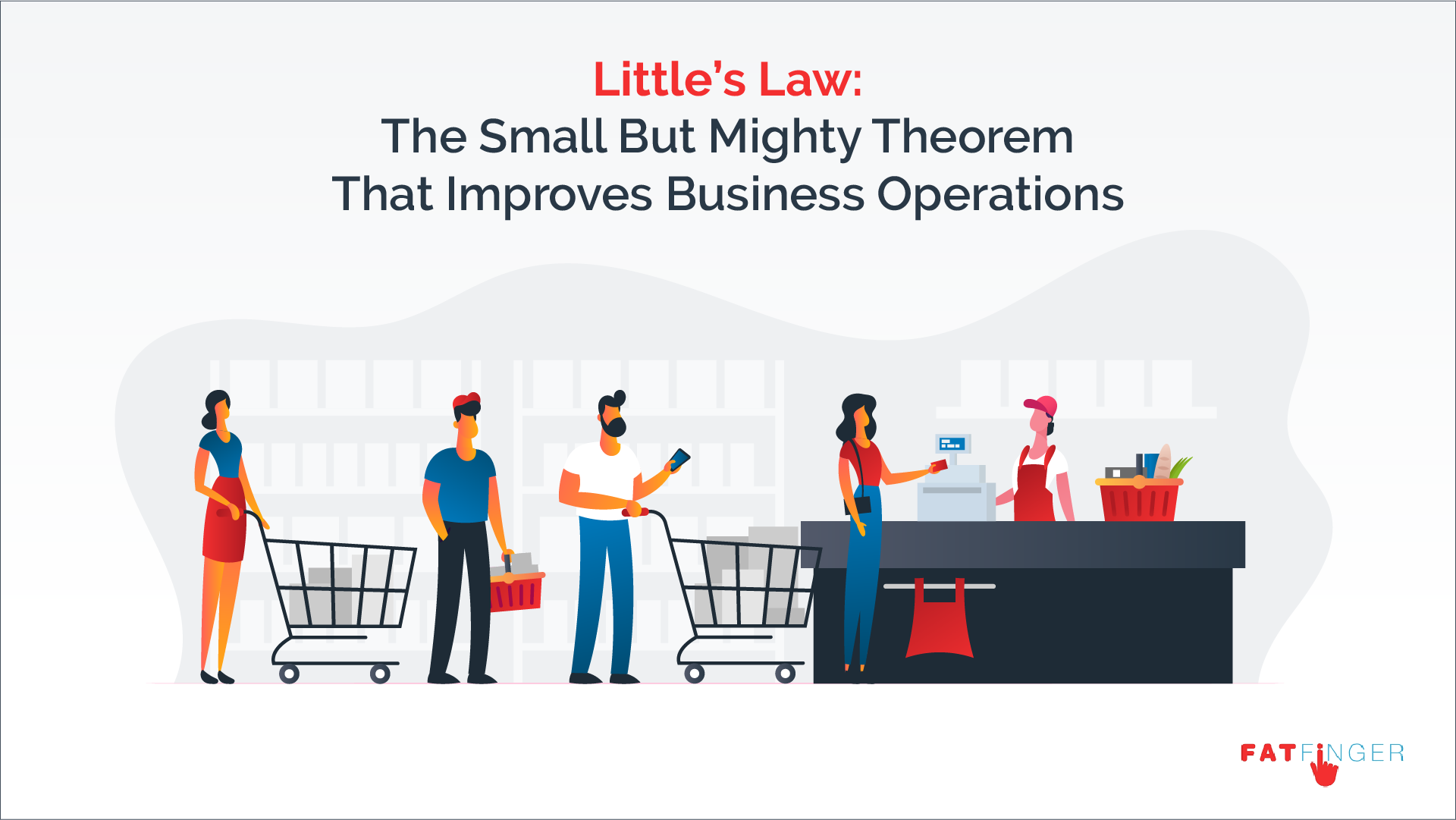
In English class, were you ever made to read (or watch the movie adaptation of) Doctor Faustus?
If so, you’ll remember that the whole plot focuses on one man’s wish to become the most knowledgeable and powerful person on the planet. In fact, he wanted it so badly, he sold his soul to the devil. Of course, things didn’t end well for Faustus when his time on Earth was up.
Thinking about it now, Doctor Faustus couldn’t be written in today’s world. It just wouldn’t make sense for us modern folk.
That’s because we have internet-enabled smartphones in our pockets, meaning we have all the knowledge (and, therefore, power) we could ever hope for. And in such a small, unassuming device, too.
It’s often the small, little things in life that pack the most punch. (I’m sure you’ve watched Game of Thrones — Tyrion Lannister is a prime example!)
Little’s law — which is an aptly-named, small but mighty theorem — can help businesses take control of and exponentially improve their business operations, thanks to the knowledge value it brings.
To learn about Little’s law, and become more knowledgeable and powerful yourself (and all without selling your soul!), just read through the following sections of this post:
- What is Little’s law?
- An easy-to-understand Little’s law example
- The versatility of Little’s law
- Why Kanban wouldn’t exist without Little’s law
- The positive impact Little’s law can have on your business
- Little’s law + FAT FINGER = massively improved business operations
Tyrion famously exclaimed, “I drink wine and I know things.” While we at FAT FINGER can’t provide you with wine, we can certainly help you know things.
So, let’s get started.
What is Little’s law?

Little’s law is a mathematical theorem established by MIT professor John Little in 1961.
The theorem helps people to figure out the average number of customers (or objects) in a queue equal to the average effective arrival rate, multiplied by the average time the customers (or objects) spend within the queue.
In algebraic form, Little’s law looks like this:
L = A x W
But in simple English, Little’s law looks like this:
The average number of customers (or objects) in a queue = The average arrival rate X The average time the customers (or objects) spend within the queue
By doing the equation yourself, and in relation to your own business, you can assess the efficiency and efficacy of a queuing system, on top of understanding if you need to be more proactive in, say, getting customers (or objects) through a queue quicker. Or, on the flip side, if the queue has to be slower for whatever reason, making the customer experience better for people waiting in the queue.
That’s Little’s law in a digestible nutshell.
But to get a stronger grasp on Little’s law, let me run through a hypothetical example.
An easy-to-understand Little’s law example

I don’t really work in the operations arm of a supermarket chain, but believe for a second that I do.
I’ve had reports from the managers of one particular midsize store that they’ve had a steady increase in customers, and that the checkout lines have become much longer, too. The longer length is making it not only stressful for the shoppers, but also for the people working behind the tills, as they’re frantically trying to scan people’s shopping quickly but still in a professional, friendly manner.
Concerned, I can use Little’s law to gauge the average number of people in each till queue, based on customers’ average arrival rates and how long the customers are spending waiting in line.
With that data, I can see that my cause for concern was justified — the average number of customers in a till queue is far higher in this particular store, when compared to other midsize stores in similarly populated areas.
A quick Google search informs me that around 400 family-sized homes were built and sold a 5-minute drive away from the store, meaning there’s been an influx of young families who are now frequenting the midsize supermarket as their primary place to pick up food and supplies.
From all this information, I can then put forward the idea of opening a smaller, more express store within the housing estate itself — or, if that’s not possible, within a very short walking distance. This idea will mean our chain retains these customers, while dividing people between the two stores, thereby shortening the average waiting time for customers in queues in the midsize store!
See?
Little’s law is small but mighty.
If there’s still a shred of confusion over how Little’s law works, I’d recommend that you check out the Corporate Finance Institute’s brilliant example. Instead of using a supermarket use case, CFI uses a coffee shop use case, explaining how Little’s law can help the coffee shop owner decide if he needs to build more seating/waiting areas for the queueing customers.
The versatility of Little’s law

In my previous example — and in my definition of Little’s law — I presented the algebraic form of Little’s law like this:
L = A x W
And this still holds true, don’t worry.
But the equation itself can be shifted around, meaning you can focus on different variables rather than just the ‘L,’ and figure out the rates of ‘A’ or ‘W’ instead.
Here’s how and why.
In plain English:
L = A x W
Is this:
The average number of customers (or objects) in a queue = The average arrival rate X The average time the customers (or objects) spend within the queue
But we can also think of the ‘L’ variable — the average number of customers (or objects) in a queue — as WIP or work-in-progress items, which is the terminology commonly used in Kanban and lean methodology circles. Similarly, the ‘A’ variable — the average arrival rate — can be thought of as throughput. And the ‘W’ variable — the average time the customers (or objects) spend within the queue — as lead time.
If you wanted to figure out — and perhaps improve — on the throughput (i.e. how quickly it takes items or objects to pass in and out of a queue) or the lead time (i.e. how short/long the wait time is) then Little’s law can be adjusted accordingly.
Instead of the regular equation, you can do:
W = L / A
Or:
A = L / W
However, for any Little’s law equation to work, the way in which the variables are being measured should be consistent, and that the queue in question is in a steady-state condition.
As the team at Kanban Zone go on to (masterfully) explain:
“Achieving a steady-state condition means that on average, the arrival and departure rate of items into and out of the system remain consistent.
Does this mean that it has to be the same every single time? Not necessarily. As we’re dealing with averages, these assumptions can afford not to hold for the entire duration of the period being observed. But do note that as you deviate more from the average, the lesser the accuracy of the equation will be. Therefore, it’s important to examine the system before using Little’s law and ensure the assumptions can hold for the majority of the time.”
Why Kanban wouldn’t exist without Little’s law

As you’ve been reading through this post, the words ‘Kanban’ and ‘lean’ have made progressively more appearances.
And there’s a good reason for that.
I know I’ve thrown a lot of maths at you thus far, and I don’t want to complicate things further, so I’ll be brief when explaining why ‘Kanban’ and ‘lean’ have cropped up more and more.
Simply put, without Little’s law, Kanban wouldn’t exist. Or, it wouldn’t exist in the way we’re used to today.
That’s because Little’s law informed Kanban as a methodology.
Kanban, in the business and tech worlds, is a lean methodology that focuses on continuous workflows. It also pays attention to eliminating Muda (waste) from workflows, systems, and process.
Little’s law — with its emphasis on figuring out waiting times, the length of actions, and bottlenecks — then, is the driver behind why Kanban teams attempt to limit WIP/work-in-progress in the first place.
If you’re not up to speed when it comes to Kanban or lean methodologies in general, have no fear. Just think of Little’s law as an easy-to-do equation that brings nothing but good for your business!
The positive impact Little’s law can have on your business

Little’s law is used by small startups and large, enterprise businesses alike — and even by government bodies, too! And they all do so because the small equation brings a whole host of benefits once calculated.
Specifically, knowing about and then using Little’s law will help your business to:
- Make efficiency improvements. At its core, Little’s law is about uncovering the average number of customers (or objects) in a queue. But if it appears that there are too many customers (or objects) in a queue at any given time, that means, somewhere, something isn’t working as well as it could be, and that the queue system isn’t running at an optimal speed. Little’s law provides you with knowledge so you and your team can take action, resulting in smoother operations.
- Better the customer’s experience. Objects don’t have feelings (or, at least, not that we know of)… so it’s not like objects get rattled when they’re in a queue for too long — for instance, when a car part is in line to be painted. But humans certainly do. No matter if they’re waiting for a coffee, to pick up a furniture purchase, or they’re waiting at the DMV, annoyance, frustration, and even anger can come to the fore. All of which is detrimental to your business, and how your business is perceived. But due to the knowledge garnered from Little’s law, you’re able to understand if changes need to be made to better accommodate customers as they queue.
- Have a healthier bottom-line. Not to be crass and make this all about money, but the fact of the matter is that the quicker your queue system is, the more customers you’ll be able to serve (or objects you’ll be able to create/alter), which means more money in your business’ pockets. To boot, being able to better the customer’s experience means repeat business, and you’re limiting the amount of not-so-great reviews appearing online which, again, is positive for your business, financially-speaking.
- Gain additional business insight. Knowledge = power. This is something I discussed at the beginning of the post, and it’s something I’m going to talk about again now — because it’s true! With Little’s law, you’re able to quickly get insight into integral aspects of your business — specifically, the queue systems in place — without having to do a big internal audit or even hire an external figure who can tell you what’s going wrong and where. You can do it all yourself, lightning-fast. How will you use the power you’ll receive from Little’s law?
- Eliminate business oversight. If you have insight, you have a better understanding of how something works or how it fares. Oversight, however, is when you failed to notice or do something. Don’t be like the companies who are, whether intentionally or unintentionally, not paying attention to the queue systems in their business. Get rid of oversight and gain insight by using Little’s law.
In a sentence, then, Little’s law is incredibly useful and helpful for your business operations.
And when paired with FAT FINGER, you’ll be able to have complete control of all of your business’ operations, once and for all.
Little’s law + FAT FINGER = massively improved business operations
FAT FINGER enables teams to digitize their essential processes, procedures, and workflows with one simple tool.
With our tool’s apps (aka digital checklists), employees will know exactly how, when, and why to tackle the tasks within any given process, be it an ISO audit or any one of the myriad manufacturing processes you may need to undertake.
We’ve built FAT FINGER with non-technical people in mind, meaning it’s super easy to understand, and super easy to use — even for those with fat fingers themselves!
Here’s how FAT FINGER works in action.
When used in tandem with Little’s law, your business will be able to not only improve how it goes about its business operations, but you’ll be able to have complete control. No more doubt, confusion, or mystery surrounding how your business is functioning and how your staff goes about their daily duties.
If you wanted, you could even make an app that runs people through the Little law equation, and then guides them on what to do with the data they’ve received (i.e. if changes need to be made to help throughput, lead time, or WIP)!
On top of our mighty apps, FAT FINGER contains a ton of state-of-the-art features, such as assignment features, notification features, authorization features, real-time dashboard reporting, even an AI coach — and much, much more.
Ready to try it yourself?
Sign up for a free account here.
Just don’t forget to check out this video from James McDonough, the CEO of FAT FINGER, as he walks you through some helpful best practices.
As I said at the beginning of the post, great things come in small packages. So I’m ending the post here.
See you inside FAT FINGER!


